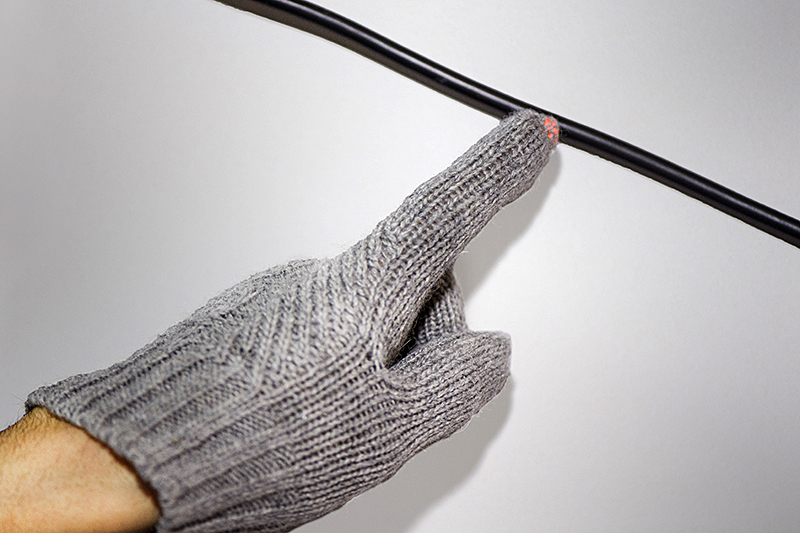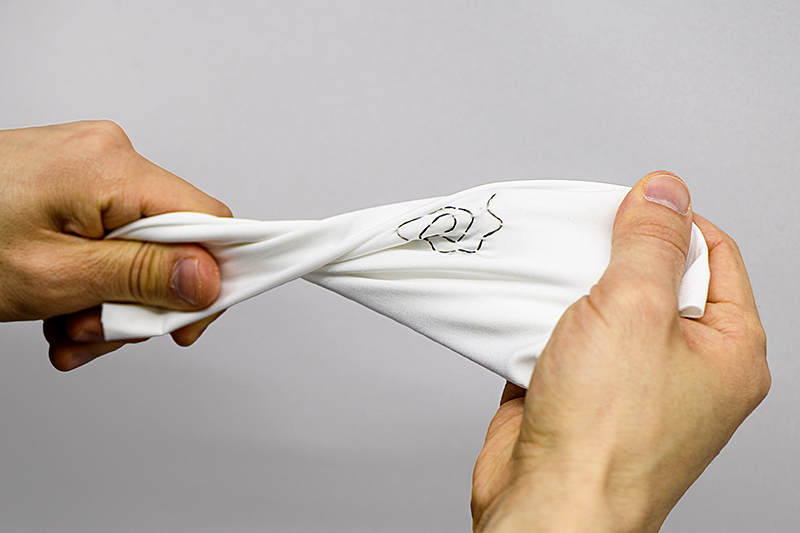Forget wearables: Future washable smart clothes powered by Wi-Fi will monitor your health

The fingertips of a wireless voltage detection glove illuminates when the wearer’s hand approaches a live cable. (Purdue University photo/Rebecca McElhoe)
In the near future, all your clothes will become smart. These smart cloths will outperform conventional passive garments, thanks to their miniaturized electronic circuits and sensors, which will allow you to seamlessly communicate with your phone, computer, car and other machines. This smart clothing will not only make you more productive but also check on your health status and even call for help if you suffer an accident. The reason why this smart clothing is not all over your closet yet is that the fabrication of this smart clothing is quite challenging, as clothes need to be periodically washed and electronics despise water.

Flexible silk-based coil has been sewn onto a smart textile and is capable of harvesting energy from radio and Wi-Fi signals in the environment. Purdue University engineers have developed a method to transform existing cloth items into battery-free wearables resistant to laundry. (Purdue University photo/Rebecca McElhoe)
Purdue engineers have developed a new spray/sewing method to transform any conventional cloth items into battery-free wearables that can be cleaned in the washing machine.
"By spray-coating smart clothes with highly hydrophobic molecules, we are able to render them repellent to water, oil and mud," said Ramses Martinez, an assistant professor in Purdue's School of Industrial Engineering and in the Weldon School of Biomedical Engineering in Purdue's College of Engineering. "These smart clothes are almost impossible to stain and can be used underwater and washed in conventional washing machines without damaging the electronic components sewn on their surface."
This technology is published in the May 25 edition of Nano Energy. Martinez's laboratory group has several videos about the technology on its dedicated YouTube channel:
- "Wireless non-contact voltage detection glove"
- "Powering OSC-based e-textiles underwater"
- "Wirelessly powered washable textiles"
The rigidity of typical waterproof garments and their reduced breathability make them feel uncomfortable after being worn for a few hours.
"Thanks to their ultrathin coating, our smart clothes remain as flexible, stretchable and breathable as conventional cotton T-shirts," Martinez said.
Unlike common wearables, the Purdue smart clothes do not require batteries for powering. By simply harvesting energy from Wi-Fi or radio waves in the environment, the clothes are capable of powering the circuitry sewn on the textile.
One example is a battery-free glove that illuminates its fingertips every time the user is near a live cable to warn about the possibility of an electric shock. Another is a miniaturized cardiac monitoring system sewn on a washable sweatband capable of monitoring the health status of the wearer.
"Such wearable devices, powered by ubiquitous Wi-Fi signals, will make us not only think of clothing as just a garment that keeps us warm but also as wearable tools designed to help us in our daily life, monitor our health and protect us from accidents," Martinez said.

A coating of fluorinated molecules is coated onto breathable and waterproof smart clothes to repel stains and withstand cleaning in conventional washing machines. (Purdue University photo/Rebecca McElhoe)
"I envision smart clothes will be able to transmit information about the posture and motion of the wearer to mobile apps, allowing machines to understand human intent without the need of other interfaces, expanding the way we communicate, interact with devices, and play video games."
This technology can be fabricated in conventional, large-scale sewing facilities, which are expected to accelerate the development and commercialization of future smart clothes.
Martinez and his team have worked with the Purdue Research Foundation Office of Technology Commercialization to protect the intellectual property. The innovations are patent pending. For information on licensing a Purdue innovation, contact the Office of Technology Commercialization at otcip@prf.org.
About Purdue Research Foundation Office of Technology Commercialization
The Purdue Research Foundation Office of Technology Commercialization operates one of the most comprehensive technology transfer programs among leading research universities in the U.S. Services provided by this office support the economic development initiatives of Purdue University and benefit the university's academic activities through commercializing, licensing and protecting Purdue intellectual property. The office recently moved into the Convergence Center for Innovation and Collaboration in Discovery Park District, adjacent to the Purdue campus. In fiscal year 2020, the office reported 148 deals finalized with 225 technologies signed, 408 disclosures received and 180 issued U.S. patents. The office is managed by the Purdue Research Foundation, which received the 2019 Innovation and Economic Prosperity Universities Award for Place from the Association of Public and Land-grant Universities. In 2020, IPWatchdog Institute ranked Purdue third nationally in startup creation and in the top 20 for patents. The Purdue Research Foundation is a private, nonprofit foundation created to advance the mission of Purdue University. Contact otcip@prf.org for more information.
About Purdue University
Purdue University is a top public research institution developing practical solutions to today’s toughest challenges. Ranked the No. 5 Most Innovative University in the United States by U.S. News & World Report, Purdue delivers world-changing research and out-of-this-world discovery. Committed to hands-on and online, real-world learning, Purdue offers a transformative education to all. Committed to affordability and accessibility, Purdue has frozen tuition and most fees at 2012-13 levels, enabling more students than ever to graduate debt-free. See how Purdue never stops in the persistent pursuit of the next giant leap at purdue.edu.
Contact: Steve Martin, sgmartin@prf.org
Source: Ramses V. Martinez, rmartinez@purdue.edu
ABSTRACT
Washable, Breathable, and Stretchable e-Textiles Wirelessly Powered by Omniphobic Silk-based Coils
Marina Sala de Medeiros, Debkalpa Goswami, Daniela Chanci, Carolina Moreno,
and Ramses V. Martinez
The commercial development of smart garments is currently hindered by significant challenges, such as dependence on batteries, reduced washability, and difficult incorporation into existing large-scale textile manufacturing technologies. This work describes an industrially-scalable approach to transform conventional fabrics into smart textiles — wirelessly powered by omniphobic silk-based coils (OSCs). OSCs are stretchable and lightweight power-receiving coils that can be easily sewn onto any textile, enabling the safe wireless powering of wearable electronics via magnetic resonance coupling without compromising the comfort of the user. OSCs are composed of microfibers made of a novel silk-nanocarbon composite that benefits from the stretchability of silk fibroin and the high conductivity of multiwall carbon nanotubes and chitin carbon nanoflakes. The surface of the OSC-powered electronic textiles (e-textiles) is rendered omniphobic — both hydrophobic and oleophobic — using a spray-based silanization method, which imbues the e-textile with waterproof and stain repellent properties without compromising its flexibility, stretchability, or breathability. OSCs exhibit excellent stability in high moisture environments and under mechanical deformations, allowing them to undergo 50 standard machine-washing cycles without degradation in performance. Moreover, OSC-powered e-textiles can be fabricated at a low cost using scalable manufacturing processes, paving the way toward the rapid development and commercialization of machine-washable and battery-free smart clothing and reusable wearable electrophysiological devices.
